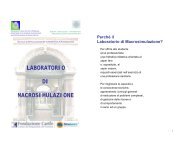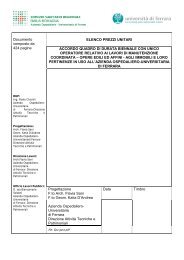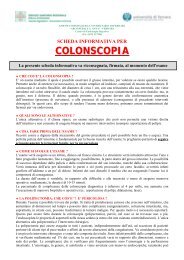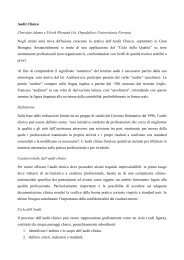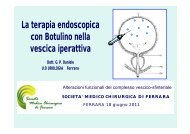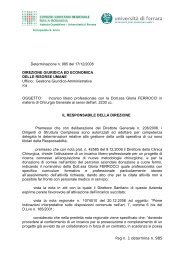Gestione pratica dei nuovi anticoagulanti orali-Pengo
Gestione pratica dei nuovi anticoagulanti orali-Pengo
Gestione pratica dei nuovi anticoagulanti orali-Pengo
Create successful ePaper yourself
Turn your PDF publications into a flip-book with our unique Google optimized e-Paper software.
Cremona, 2 marzo 2012<br />
<strong>Gestione</strong> <strong>pratica</strong> <strong>dei</strong> <strong>nuovi</strong><br />
<strong>anticoagulanti</strong><br />
Vittorio <strong>Pengo</strong><br />
Clinical Cardiology, Padua, Italy
Quali pazienti dovrebbero essere fin da subito trattati<br />
con <strong>nuovi</strong> farmaci <strong>anticoagulanti</strong> <strong>orali</strong> (NAO)<br />
• Tutti i pazienti con caratteristiche simili a quelli arruolati negli studi<br />
clinici di Fase III (Grado A)<br />
• I pazienti con pregressa emorragia intracranica (Grado A)<br />
• Pazienti ad alto rischio di ictus (Grado A)<br />
• Pazienti che desiderano ricevere il nuovo farmaco .<br />
• Pazienti con problemi logistici che rendono difficile il monitoraggio<br />
laboratoristico, come quelli allettati per altre patologie.<br />
Guida FCSA 2012
In quali pazienti i NAO dovrebbero rimpiazzare<br />
i farmaci VKA ?<br />
• Pazienti trattati con AVK che presentano un TTR (time spent in<br />
therapeutic range) inferiore al 50-55%. (Grado A)<br />
• Pazienti con importanti problemi logistici o lavorativi.<br />
• Pazienti con pregressa emorragia cerebrale (Grado A).<br />
• Pazienti che utilizzano farmaci che interferiscono con gli VKA ,<br />
provocando continue oscillazioni dell’INR.<br />
• Pazienti che preferiscono i <strong>nuovi</strong> farmaci <strong>anticoagulanti</strong> o che non<br />
vogliono più fare i prelievi di controllo.<br />
Guida FCSA 2012
Come passare da warfarin ai NAO?<br />
• Se l’INR è ≤ 2 si possono assumere subito i NAO.<br />
• Se l’INR è compreso tra 2.0 e 3,0, sospendere il<br />
warfarin e iniziare i NAO quando INR inferiore a 2,<br />
presumibilmente 48 ore dopo l’ultima assunzione di<br />
warfarin.<br />
• Se l’INR è >3, sospendere il warfarin e controllare<br />
l’INR dopo 48 ore.<br />
Guida FCSA 2012
Come passare da eparina ai NAO?<br />
• Subito prima della dose successiva di LMWH o<br />
fondaparinux<br />
• Dopo 90 minuti dalla sospensione della infusione di<br />
eparina endovena o quando aPTT è rientrato nella<br />
norma
Cosa fare prima del trattamento<br />
•aPTT, PT e un emocromo con conta delle piastrine, funzione<br />
epatica e renale (clearance della creatinina).<br />
•Anamnesi farmacologica per farmaci potenzialmente interferenti<br />
•Educazione del paziente<br />
•Portare con sé un documento che certifichi l’uso del farmaco<br />
•Centro Trombosi o medico di riferimento in caso di problemi
Potenziali interazioni farmacologiche <strong>dei</strong> NAO<br />
Inibitori della P-glicoproteina<br />
Amiodarone, Fenotiazina, Acido<br />
Carbossilico, Antifungini azolici, Verapamil,<br />
Antimalarici, Ciclosporinea Tioxanteni.<br />
Induttori della P-glicoproteina<br />
Desametasone, Rifampicina, Erba di<br />
S.Giovanni.<br />
Inibitori del CYP3A4<br />
Fenotiazina, Acido Carbosslico, Antifungini<br />
azolici, , Verapamil, Eritromicina,<br />
Telitromicina, Nefazodone, Antimalarici,<br />
Ciclosporina, Tioxantenei<br />
Induttori del CYP3A4<br />
Carbamazepina, Efavirenz, Nevirapinea<br />
Fentoina, Fenobarbitone, Rifabutin,<br />
Rifapentina, Rifampicina, Erba di<br />
S.Giovanni, Alcohol, Eucaliptolo.<br />
FANS<br />
Aspirina, Naproxene, Diclofenac.<br />
DABIGATRAN RIVAROXABAN, EDOXABAN,<br />
APIXABAN<br />
Si Si<br />
Si Si<br />
No Si<br />
No Si<br />
Si Si<br />
Agenti antipiastrinici<br />
Clopidogrel Si Si<br />
Guida FCSA 2012
Recommended dose<br />
Dose can be<br />
considered<br />
Dabigatran: la scelta del dosaggio<br />
Patient has risk<br />
factors for stroke<br />
Estimated CrCl<br />
Recommended dose<br />
Dose can be<br />
considered<br />
Dabigatran: la scelta del dosaggio<br />
Patient has risk<br />
factors for stroke<br />
Estimated CrCl<br />
Cosa fare durante il trattamento<br />
•Visite a 3, 6, 12 mesi dall’inizio del trattamento e poi<br />
annualmente<br />
•Controllare la funzione renale almeno una volta all’anno<br />
•Ogni 6 mesi se la creatinina clearance è tra 30 e 50 ml/min o se<br />
il pz ha una età superiore a 75 anni<br />
•Controllare la aderenza al trattamento
Cosa si può fare per aumentare la<br />
aderenza/persistenza alla terapia?<br />
• Visite di follow up sistematiche da parte di:<br />
i. Medico prescrittore<br />
ii. Medico di Medicina generale<br />
iii. Medico di un Centro Trombosi accreditato<br />
iv. Farmacisti del territorio (annotano la frequenza di approvvigionamento del<br />
farmaco)<br />
v. Paramedici sul territorio per i pazienti in ADI<br />
• Altre misure meno efficaci per aumentare la compliance:<br />
i. Chiamata telefonica<br />
ii. Registro tenuto dal paziente<br />
iii. Una ampia educazione al momento della prescrizione<br />
iv. Depliant e questionari<br />
<strong>Pengo</strong> V et al. Thromb Haemost 2011
Quanto tempo dovrebbe passare tra la sospensione <strong>dei</strong><br />
NAO ed un intervento chirurgico elettivo ?<br />
Dabigatran:<br />
Controllo di laboratorio?<br />
Pradaxa scheda tecnica
Pazienti da sottoporre al test di laboratorio<br />
Nei pazienti in terapia con NAO, il monitoraggio di laboratorio non è<br />
generalmente necessario. Fanno tuttavia eccezioni alcune condizioni:<br />
• Necessità di sottoporre pazienti in terapia con NAO ad interventi invasivi.<br />
• Pazienti che si presentino in emergenza con eventi trombotici o emorragici e senza chiare<br />
indicazioni in merito alla terapia. In queste circostanze, può essere utile conoscere la<br />
tipologia del NAO assunto, ed il dosaggio ematico attuale.<br />
• Necessità di antagonizzare rapidamente l’effetto anticoagulante del farmaco.<br />
• Pazienti con insufficienza renale o epatica, in cui il metabolismo <strong>dei</strong> NAO può essere alterato.<br />
• Interazione con altri farmaci che possono ridurre o potenziare l’effetto <strong>dei</strong> NAO.<br />
• Pazienti con estremi di peso (eccessiva magrezza o obesità).<br />
Guida FCSA 2012
Quale test di laboratorio?<br />
(alla seconda ora dopo la somministrazione o prima della somministrazione successiva?)<br />
Dabigratan<br />
Si raccomanda l’esecuzione del Tempo di Trombina diluito (dTT), del<br />
tempo di ecarina (Ecaring Clotting Time, ECT) o del tempo di trombina<br />
(Thrombin Clotting Time, TCT).<br />
Rivaroxaban<br />
Si raccomanda l’esecuzione dell’attività anti-FXa o del tempo di<br />
protrombina (PT).<br />
I risultati del PT devono essere espressi in termini di rapporto (paziente su<br />
normale), mentre è sconsigliata l’espressione in termini di INR
Altri suggerimenti pratici<br />
• In caso di dimenticanza nell’assunzione di un NOA,<br />
non assumere la dose doppia il giorno dopo.<br />
• Istruire bene il paziente ed il medico di medicina<br />
generale in modo che il NOA non venga sospeso<br />
anche temporaneamente in caso di emorragie minori<br />
o trascurabili ancorchè vistose (es, emorragia<br />
congiuntivale)
Emorragie in pazienti trattati con dabigatran<br />
• Delay next dose<br />
or discontinue<br />
treatment* as<br />
appropriate<br />
Comment:<br />
dangerous<br />
• Symptomatic Rx<br />
• Mechanical<br />
compression<br />
• Fluid replacement<br />
• Blood transfusion<br />
• Oral charcoal *<br />
• Haemodialysis<br />
PCC = prothrombin complex concentrates; rFVIIa = recombinant Factor VIIa; Rx =treatment<br />
*Recommendation based only on limited non-clinical data; there is no experience in volunteers or patients<br />
van Ryn J et al. Thromb Haemost 2010;103:1116–27<br />
• Consideration of<br />
rFVIIa or PCC*<br />
• Charcoal filtration*<br />
An antidote for<br />
dabigatran is<br />
currently in<br />
development<br />
16
Emorragie in pazienti trattati con rivaroxaban<br />
• Delay next dose<br />
or discontinue<br />
treatment* as<br />
appropriate<br />
*Comment:<br />
dangerous<br />
• Symptomatic Rx<br />
• Mechanical<br />
compression<br />
• Fluid replacement<br />
• Blood transfusion<br />
PCC = prothrombin complex concentrates; rFVIIa = recombinant Factor VIIa; Rx =treatment<br />
• PCC (4 fattori)<br />
50UI/kg<br />
• rFVII
Raccomandazioni per il follow up <strong>dei</strong> pazienti<br />
trattati con NAO<br />
• E’ opportuno che questi pazienti entrino in un registro che raccolga le<br />
caratteristiche di pazienti ed il tipo di trattamento<br />
• Che vi sia una registrazione puntuale degli eventi trombotici ed emorragici<br />
e della mortalità<br />
• I pazienti che mancano ad una visita di controllo andrebbero rintracciati<br />
direttamente o tramite il MMG con individuazione della causa del<br />
mancato controllo<br />
• Un registro di questo genere (START Registry) è attivo dal 2011, ma ha<br />
arruolato finora solo soggetti trattati con VKA data la indisponibilità in<br />
Italia <strong>dei</strong> NAO
Switching patients to dabigatran<br />
Warfarin to dabigatran<br />
Parenteral to dabigatran<br />
Start dabigatran up<br />
to 2 hours before<br />
next parenteral drug<br />
dose<br />
INR = international normalized ratio<br />
Huisman M et al. Thromb Haemost doi:10.1160/TH11-10-0718<br />
Continuous infusions to<br />
dabigatran<br />
Start dabigatran at<br />
time of<br />
discontinuation of<br />
continuous infusion<br />
20
If a patient misses a dose<br />
The 6-hour rule<br />
Time since missed dose Recommendation<br />
6 hours The patient should wait until their next<br />
scheduled dose<br />
Huisman M et al. Thromb Haemost doi:10.1160/TH11-10-0718<br />
21
Temporary discontinuation for elective<br />
When to stop dabigatran:<br />
Renal function<br />
(CrCl in mL/min)<br />
surgery<br />
Standard bleeding risk High bleeding risk*<br />
≥80 24 hours before 2 days before<br />
≥50 to
There is no need for routine monitoring<br />
but in certain emergency situations it<br />
may be advisable to assess coagulation<br />
Close correlation between dabigatran<br />
status<br />
plasma concentration and degree of<br />
anticoagulant effect<br />
ECT (ratio)<br />
TT (sec)<br />
12<br />
9<br />
6<br />
3<br />
0<br />
45<br />
40<br />
35<br />
30<br />
25<br />
20<br />
15<br />
10<br />
5<br />
0<br />
a<br />
0 200 400 600 800 1000<br />
Dabigatran plasma concentration (ng/mL)<br />
c<br />
Multiple dose<br />
y = 1.358 + 0.00962x<br />
r 2 = 0.9164<br />
Multiple dose<br />
y = 2.4040 + 0.05851x<br />
r 2 = 0.8568<br />
0 200 400 600 800 1000<br />
Dabigatran plasma concentration (ng/mL)<br />
ECT = ecarin clotting time; PT = prothrombin time; TT = thrombin time; aPTT = activated partial thromboplastin time<br />
van Ryn J et al. Thromb Haemost 2010;103:1116–27<br />
PT (INR)<br />
aPTT (ratio)<br />
4.8<br />
4.4<br />
4.0<br />
3.6<br />
3.2<br />
2.8<br />
2.4<br />
2.0<br />
1.6<br />
1.2<br />
0.8<br />
3.6<br />
3.2<br />
2.8<br />
2.4<br />
2.0<br />
1.6<br />
1.2<br />
0.9<br />
b<br />
0 200 400 600 800 1000<br />
Dabigatran plasma concentration (ng/mL)<br />
d<br />
Multiple dose<br />
y = 1.047 + 0.00246x<br />
r 2 = 0.8459<br />
Multiple dose<br />
y = 0.86 + 0.06873x 1/2<br />
r 2 = 0.8514<br />
0 200 400 600 800 1000<br />
Dabigatran plasma concentration (ng/mL)<br />
INR is not sufficiently sensitive and cannot be recommended<br />
23
Interpretation of coagulation assays to<br />
Activated partial<br />
thromboplastin time (aPTT)<br />
May be useful in determining<br />
an excess of anticoagulant<br />
activity 1,2<br />
assess<br />
bleeding risk: aPTT<br />
Clinically relevant<br />
measurement<br />
An aPTT >80 seconds at<br />
trough (when the next dose<br />
is due) is associated with a<br />
higher risk of bleeding 1,3<br />
INR = international normalized ratio<br />
1. van Ryn J et al. Thromb Haemost 2010; 103:1116–1127; 2. Liesenfeld K-H et al. Br J Clin Pharmacol 2006; 62:527–537; 3.<br />
Huisman M et al. Thromb Haemost doi:10.1160/TH11-10-0718<br />
24
Tests that assess the risk of bleeding –<br />
Thrombin time (TT) test<br />
The TT test measure will depend<br />
on the coagulometer and on the<br />
thrombin lot used<br />
It is therefore advisable to use the<br />
calibrated Hemoclot ® Thrombin<br />
Inhibitor assay* (a diluted TT<br />
assay) with dabigatran standards<br />
* Hyphen BioMed, Neuville-sur-Oise, France; BID = twice daily;<br />
van Ryn J et al. Thromb Haemost 2010;103:1116–27<br />
TT<br />
Clinically relevant measurement<br />
A TT measure (calibrated<br />
Hemoclot ® thrombin inhibitor assay)<br />
of >200 ng/mL dabigatran plasma<br />
concentration (approximately >65<br />
seconds) prior to the next drug<br />
intake after 150 mg BID<br />
dosing (trough measure, i.e. 10–16<br />
hours after the previous dose) is<br />
associated with a higher risk of<br />
bleeding<br />
A normal TT measurement<br />
indicates no clinically relevant<br />
anticoagulant effect of dabigatran<br />
25
Thrombolysis in patients with acute<br />
ischaemic stroke<br />
Intravenous administration of rtPA is effective if given to eligible patients within 4.5<br />
hours of symptom onset<br />
• The use of thrombolysis in patients receiving<br />
concurrent dabigatran has not been studied<br />
– May increase the risk of bleeding<br />
• In patients considered candidates for<br />
thrombolysis measurement of the aPTT,<br />
or TT are appropriate initial tests<br />
– A normal result for one of these assays<br />
generally indicates that the bleeding risk is low<br />
aPTT = activated partial thromboplastin time; ECT = ecarin clotting time; INR = international normalized ratio;<br />
TT = thrombin time; rtPA = recombinant tissue plasminogen activator<br />
Huisman M et al. Thromb Haemost doi:10.1160/TH11-10-0718<br />
26
RCP, 2012
When to start dabigatran after an<br />
TIA = transient ischaemic attack<br />
Huisman M et al. Thromb Haemost doi:10.1160/TH11-10-0718<br />
acute stroke?<br />
Stroke Severity Restart dabigatran<br />
TIA<br />
As soon as imaging has excluded<br />
a cerebral haemorrhage<br />
Mild Stroke 3–5 days after symptom onset<br />
Moderate Stroke 5–7 days after stroke onset<br />
Severe Stroke 2 weeks after stroke onset<br />
28
A practical guide to Dabigatran therapy:<br />
important Topics<br />
How to pick the right dose?<br />
How to switch to dabigatran?<br />
How to manage interruptions?<br />
How to measure the anticoagulant effect?<br />
How to manage acute ischaemic stroke?<br />
How to manage bleeding?<br />
29
Anticoagulants<br />
John W. Eikelboom, Circulation. 2010;121:1523-1532.
Dabigatran Rivaroxaban Apixaban Edoxaban Betrixaban<br />
Target IIa Xa Xa Xa Xa<br />
Hours to Cmax 2 2-4 1-3 1-2 NR<br />
Prodrug Yes No No No No<br />
CYP metabolism No 32% 15% NR No<br />
Bioavailability 7% 80% 66% >45% 34%-47%<br />
Tranporters Pgp Pgp Pgp Pgp Pgp<br />
Protein binding 35% >90% 87% 55% NR<br />
Half-life (hours) 12-14 9-13 8-15 8-10 19-20<br />
Renal elimination 80% 66% 25% 35%
Advantages using New Anticoagulants<br />
Rapid onset of action No need for bridging<br />
Predictable anticoagulant effect No need for routine<br />
coagulation monitoring<br />
Specific coagulation enzyme target Low risk of off-target<br />
adverse effects<br />
Low potential for food interactions No dietary precautions<br />
Low potential for drug interactions Few drug restrictions<br />
Eikelboom JW, Circulation 2010
Rely<br />
2009<br />
Rocket<br />
2011<br />
Aristotele<br />
2011
Risk factors Dabigatran<br />
110mg<br />
N= 6015<br />
Dabigatran<br />
150mg<br />
N=6076<br />
Rivaroxaban 20mg<br />
N=7131<br />
Apixaban 5 mg<br />
N=9120<br />
Age (years) 71 4 ± 8.6 71.5 + 8.8 73 (65-78)** 70 (63-76)**<br />
Female sex (%) 35.7 35.8 39.7 35.5<br />
Weight (Kg) 82.9 ± 19.9 82.5 ± 19.4 28.3 (25.2-32.1)**§ 82 (70-96)**<br />
Prior stroke or<br />
embolism %<br />
Characteristics of randomized patients<br />
19.9 20.3 54.9 19.2<br />
Heart failure % 32.2 31.8 62.6 35.5<br />
Diabetes % 23.1 23.4 40.4 25.0<br />
Hypertension % 78.8 78.9 91.3 87.3<br />
CHADS2 score (mean) 2.1 ± 1.1 2.2 ± 1.2 3.48 ± 0.94 2.1 ± 1.1<br />
**median (interquartile range) ; § Body Mass Index.
Dabigatran Rivaroxaban Apixaban for Stroke<br />
prevention in AF<br />
• Non inferiority Vs Warfarin in stroke and<br />
peripheral embolism prevention: YES<br />
• Superiority:<br />
EFFICACY<br />
Dabigatran 150mg/bid<br />
Apixaban 5mg/bid
Dabigatran Rivaroxaban Apixaban for Stroke<br />
prevention in AF<br />
SAFETY<br />
• Signifantly less major bleeding:<br />
Dabigatran 110mg/bid*<br />
Apixaban<br />
• Signifantly less cerebral bleeding :<br />
Dabigatran 110mg/bid and 150mg/bid<br />
Rivaroxaban<br />
Apixaban
Dabigatran Rivaroxaban Apixaban for Stroke<br />
prevention in AF<br />
Clinical Events Study Drugs<br />
Death from any<br />
cause<br />
RE-LY<br />
Death from any cause<br />
%/y<br />
NOA W<br />
Relative Risk<br />
(95%CI)<br />
P<br />
value<br />
Dabigatran 110 3,75 4,13 0,91 (0,80-1,03) 0,13<br />
Dabigatran 150 3,64 4,13 0,88 (0,77-1,00) 0,051<br />
ROCKET-AF Rivaroxaban 4,5 4,9 0,92 (0,82-1,03) 0,15<br />
ARISTOTELE Apixaban 3,52 3,94 0,89 (0,80-0,99) 0,047
Potential problems using New Anticoagulants<br />
Adherence and persistence to treatment: very important in light of the<br />
short half-life of new oral anticoagulants<br />
Renal Function<br />
Treatment of major or life threatening bleeding<br />
Potential drug interactions<br />
Side-effects and potential drop-out<br />
Costs
Medication adherence?<br />
After acute coronary syndrome:<br />
Continuous use of drugs after 6-12 months<br />
-Aspirin 71%<br />
-beta-blockers 46%<br />
-statins 44%<br />
-All the three medications 21%<br />
Newby LK, Circulation 2006
What can be practically done to<br />
improve adherence/persistence?<br />
Systematic follow-up visits (Grade B recommendation)<br />
at least every six months (check for adverse events,<br />
renal function, dyspepsia) by either:<br />
● Prescribing physician<br />
● General practitioner<br />
● Thrombosis center physician<br />
● Community pharmacist (refill frequency)<br />
● Caregivers<br />
<strong>Pengo</strong> V et al. Thromb Haemost 2011
Renal function<br />
Patients with creatinine clearance < 30ml/min were excluded from<br />
dabigatran and rivaroxaban trials; those with a creatinine clearance <<br />
25ml/min were excluded from apixaban trial<br />
Patients with creatinine clearance 30 to 50 ml/min received reduced dose<br />
in Rocket-AF (15mg/qd). Patients with a serum creatinine level of 1.5<br />
mg per deciliter (133 μmol per liter) or more received a reduced dose<br />
of apixaban (2.5mg/bid)<br />
Control of renal function?<br />
Periodic ( at least every year) evaluation of renal function especially in<br />
the elderly and fragile patients.
No antidote<br />
Major or life-threatening bleeding<br />
Laboratory tests?<br />
Fresh Frozen Plasma?<br />
Prothrombin complex concentrate?<br />
Recombinant Activated factor VII (rFVIIa)?
Laboratory tests<br />
• Importance to know which one of the new anticoagulants is<br />
taken<br />
• Ecarin Clotting Time (ECT) or aPTT (if ECT is not available) for<br />
dabigatran or diluted thrombin time (dTT) should be<br />
recommended<br />
• Prothrombin Time (PT) for rivaroxaban and for apixaban should<br />
be recommended<br />
• It is recommended to do testing after 2–3 months from the<br />
initiation of the therapy in order to have a steady-state laboratory<br />
value that may be useful in the future if adverse clinical events<br />
will occur.
How should patients with major<br />
or life-threatening bleeding be treated?<br />
● Direct thrombin inhibitors are hardly counteracted by PCC or FFP.<br />
Dabigatran could be adsorbed via haemoperfusion over a charcoal<br />
filter. In case of major-life threatening bleeding, haemodialysis is a<br />
therapeutic option .<br />
● Direct FXa inhibitors could be (partially) antagonised by nonactivated<br />
four-factor PCCs. They contain factor II-VII-IX-X and dosage could be<br />
50UI/Kg by one-shot administration.<br />
Eerenberg ES,Circulation. 2011;124:1573-1579
Drugs affecting the efflux tranporter P-glycoprotein and the<br />
cytocrome 450 metabolism<br />
P-gp<br />
inhibitors<br />
P-gp<br />
inducers<br />
P-gp<br />
substrate<br />
CYP3A4<br />
inhibitors<br />
CYP3A4<br />
inducers<br />
CYP3A4<br />
substrate<br />
Amiodarone Dexamethasone Digoxin Phenotiazin Carbamazepine Midazolam<br />
Phenotiazin Rifampicin Atorvastatin Carboxylic Acid Efavirenz Atorvastatin<br />
Carboxylic acid St. John’s Wort Verapamil Nevirapine<br />
Azole<br />
antifungals<br />
Dabigatran<br />
Rivaroxaban<br />
Apixaban<br />
Carbamazepine Azole<br />
antifungals<br />
Rivaroxaban<br />
Apixaban<br />
Phenytoin<br />
Verapamil Phenytoin Erythromycin Phenobarbital<br />
Antimalarial Telithromycin Rifabutin<br />
Cyclosporine Nefazodone Rifapentine<br />
Thioxanthenes Antimalarial Rifampicin<br />
Ketoconazole Cyclosporine St. John's wort<br />
Quinidine Thioxanthenes Alcohol<br />
Ketoconazole Eucalyptol
General recommendations before starting new OAC<br />
(I)<br />
New oral anticoagulants may be prescribed by specialists in cardiology,<br />
neurology, internal medicine, or by Thrombosis Centres (treatment plan).<br />
Before prescribing the following steps should be followed:<br />
● Comply with the indications and contraindications of individual new OAC.<br />
● Explain to the patient the characteristics of various available drugs.<br />
● Take into account the patient preferences in the choice of treatment. Once<br />
the treatment is chosen then it is needed to make a correct and complete<br />
information and patient education.<br />
<strong>Pengo</strong> V et al. Thromb Haemost 2011
General recommendations before starting new OAC<br />
(II)<br />
● Arrange personally the follow-up or through the support of Thrombosis<br />
Centres or by express agreement with the general practitioner (GP).<br />
● Advise the patient to keep a personal identification card, containing<br />
personal information, the type of anticoagulant treatment in progress, an<br />
address reference with telephone number for contact by the patient in<br />
case of need or by another physician for any emergency.<br />
● Check blood cell count, PT, APTT, liver function tests and the creatinine<br />
clearance in all subjects over 75 years of age.
• Independent<br />
• Open to everyone<br />
• Multisponsored<br />
START Registry<br />
• Involves the construction of the central database,<br />
and its connection with the peripheral database of<br />
participating centers<br />
• Prospectively records the events in naive patients<br />
treated with anticoagulants both old and new<br />
gualtiero.palareti@unibo.it<br />
vittorio.pengo@unipd.it
Which patients with AFib should be prioritized<br />
in taking the new oral anticoagulants?<br />
• Patients with unstable INR<br />
• Patients with history of intracranial bleeding<br />
• Patients willing to be prescribed the new<br />
drugs.<br />
• Patients with logistic problems<br />
• Patients in whom warfarin was not prescribed
Dabigatran Rivaroxaban Apixaban for Stroke<br />
prevention in AF<br />
TTR accounts for the standard of care in warfarin arm<br />
Warfarin TTR<br />
(%)<br />
Dabigatran Rivaroxaban Apixaban<br />
64 55 62.2
Local standards of care affect the benefits of use of new<br />
treatment alternatives<br />
Wallentin L, Lancet 2010
Which patients with AFib should be prioritized<br />
in taking the new oral anticoagulants?<br />
• Patients with unstable INR<br />
• Patients with history of intracranial bleeding<br />
• Patients willing to be prescribed the new<br />
drugs.<br />
• Patients with logistic problems<br />
• Patients in whom warfarin was not prescribed
Management of AF in Italian primary care<br />
Mazzaglia G, Thromb Haemost 2010
Use of aspirin in AFib according to age<br />
Mazzaglia G, Thromb Haemost 2010
Patients in whom the new drugs may not<br />
replace coumarins.<br />
•Patients with severe renal failure<br />
•Patients with both a stable INR and a low bleeding<br />
risk<br />
•Patients who scarcely adhere to treatment
Dabigatran Rivaroxaban Apixaban for Stroke<br />
prevention in AF<br />
Premat discont<br />
(%)<br />
Results<br />
Dabigatran Rivaroxaban Apixaban<br />
15 24 25<br />
Back to warfarin? A different NOA?



